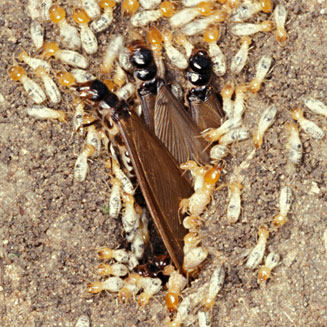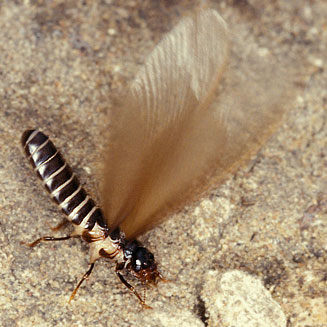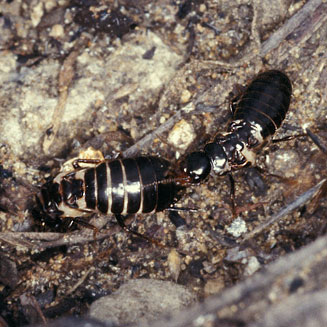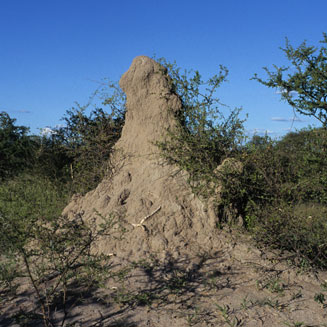|
Isoptera (termites)
Life
> Eukaryotes >
Opisthokonta >
Metazoa (animals) > Bilateria > Ecdysozoa
> Panarthropoda > Tritocerebra > Phylum:
Arthopoda > Mandibulata >
Atelocerata > Panhexapoda >
Hexapoda
> Insecta (insects) > Dicondyla > Pterygota >
Metapterygota > Neoptera > Polyneoptera >
Dictyoptera (cockroaches, mantises and
termites)
Termites are social cockroaches and are among the most important groups of animals on
land because they play a vital role in breaking down dead plant material. They have
symbiotic flagellates or bacteria in their hindguts that are able to break down plant
cellulose to a digestible form and in the subfamily Macrotermitinae the termites culture
and eat fungi in their nests using dead plant material.
Life Cycle of termites
 |
 |
|
1. Winged reproductives ('alates') emerge from the
nest entrance, surrounded by workers trying to protect them from predators.
[photo HG Robertson ©] |
2. The alate female flies some distance from the
nest, then settles on the ground, tips her abdomen in the air and releases a sex pheromone
into the air, its dispersal aided by beating of the wings. [photo HG
Robertson ©] |
 |
 |
|
3. A male locates the advertising female, settles
beside her, they recognize each other, brake off their wings and then, as shown in this
photograph, scuttle off together to find a suitable nest site. [photo HG
Robertson ©] |
4. After finding a nest site, the male
('king') mates with the female ('queen') and the queen starts laying eggs. The colony
steadily grows, in many species a large mound is formed and eventually it reaches a size
where they have sufficient resources to produce reproductives and repeat the cycle.
[photo HG Robertson ©] |
Ants (order: Hymenoptera; family: Formicidae) are often confused with termites because
they are also social, and termites are sometimes called 'white ants' (a confusing term).
Ants are social wasps and have a constriction half way down their body
whereas in termites the body is uniformly broad. The prominent mounds you see in the South
African countryside are made by termites not ants. Whereas ant workers are all females, in
termites, workers can be either male or female. In ants, mating occurs before the nest is
founded and the male dies after mating - he does not become a king and live and mate with
the queen in the new colony, as in termites.
People eat termites
"Termites are considered a delicacy in most parts of Africa. The queen
is considered to be an exquisite dish and is often fed to children (Uganda and
Zambia). The soldiers and the reproductive form are also eaten. Termites are
fried in their own fat or steamed in banana leaves (Uganda). Fried or dried,
they contain 32-36% protein... The most popular are the sexual winged forms of
the large species (Macrotermitinae) which emerge from holes in their mounds
after the first rains, often at night. They are collected in various ways. In
urban areas, they are attracted to electric light and are trapped in receptacles
of water placed under or near the light source. In rural areas, they are caught
when emerging from the termite mounds. Attracted by the light of a grass torch,
the termites are swept up with a broom into a dug-out hole. Another method is to
build a tent-like structure of branches and leaves to cover some of the
emergence holes. By closing the other emergence holes, the termites have to
emerge from the holes in the tent structure, which has an opening on one side to
which the flying termites are attracted by artificial light, sunlight or
moonlight. Near this opening, a receptacle is placed to collect the termites.
Osmaston (1951) mentions from Uganda a complicated structure of clay pipes
constructed over the emergence holes and leading to the receptacle. He and
several of my informants reported that drumming on the ground triggers certain
termite species to emerge.
Soldiers from the larger species are also eaten. To extract
them from the mounds, saliva-wetted grass blades are lowered into the shafts of
opened termite mounds. In defence, the soldiers bite into the blades and are
then subsequently stripped from the blades into a container. They can either be
fried or pounded into a cake. Sometimes only the heads are eaten (Uganda)."
(van Huis 1996)
Publications (by date)
-
Skaife, S.H. 1956. Dwellers in Darkness: an Introduction to the Study of Termites.
Longmans Green & Co., London.
-
Wilson, E.O. 1971. The Insect Societies. Harvard University Press, Cambridge,
Massachusetts.
-
Skaife, S.H. 1979. African Insect Life. Struik, Cape Town, pp. 47-58.
-
van Huis, A. 1996. The traditional use of
arthropods in sub Saharan Africa. Proceedings of the section Experimental
and Applied Entomology of the Netherlands Entomological Society 7: 3-20.
-
Backwell LR, d’Errico F. 2001. Evidence of termite
foraging by Swartkrans early hominids. Proceedings of the National Academy
of Sciences, United States of America 98(4): 1358-1363.
-
Uys, V. 2002. A guide to the termite genera of southern
Africa. Plant Protection Research Institute, Agricultural Research
Council, Pretoria, 116 pp.
|
